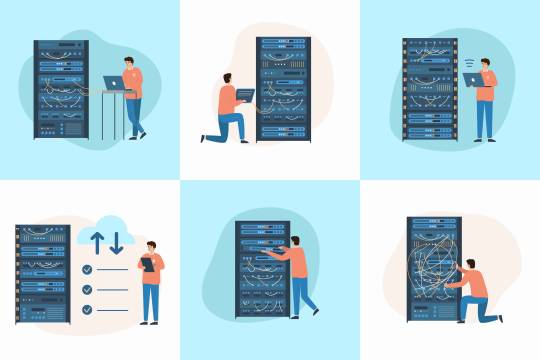#Deployment Image Servicing and Management
Explore tagged Tumblr posts
Text
#AI Factory#AI Cost Optimize#Responsible AI#AI Security#AI in Security#AI Integration Services#AI Proof of Concept#AI Pilot Deployment#AI Production Solutions#AI Innovation Services#AI Implementation Strategy#AI Workflow Automation#AI Operational Efficiency#AI Business Growth Solutions#AI Compliance Services#AI Governance Tools#Ethical AI Implementation#AI Risk Management#AI Regulatory Compliance#AI Model Security#AI Data Privacy#AI Threat Detection#AI Vulnerability Assessment#AI proof of concept tools#End-to-end AI use case platform#AI solution architecture platform#AI POC for medical imaging#AI POC for demand forecasting#Generative AI in product design#AI in construction safety monitoring
0 notes
Text
Welcome to Vau's! - Chapter 1
Fries & Rings
Delta Squad × OC | Modern AU | Fast Food Worker AU
Next Chapter ↦

✧ Chapter Summary: Raye's first time at Vau's—a local fast food place that everybody else at hometown seems to go to.
✧ Warnings: maybe US military thingy inaccuracies bcs I'm not from there and curse words, other than that; none :)
✧ Word Count: 2.7k
COLLAB WITH @carbon-corrie | Credits: OC Paisley Jettster and the amazing header image belongs to Carbon, as well as some prompts and/or dialogue lines!

“Seven months of Oki deployment and first thing you do when you got home is driving out for greasy food.”
“Yup,” Eli says, popping the ‘p’.
Raye scoffs from the passenger seat. “And not a fucking nap.”
“Ay. Language, Raye.” Even with his focus on the neighborhood road ahead, Eli points a scolding finger at her—a sign that the traffic is not his sole focus at all. “I'm still your older brother.”
“It's literally nothing more than whatever you've said during service.”
“We don't curse as much in the Marines, trust me.”
Raye glares at him. At his stupid military regulations high-and-tight haircut and the smug smile lines because he's a goof of a brother. No idea how he's managed to maintain his sense of humor from being a goddamn Marine. From all she knows, it’s all horrors. Especially when one gets Okinawa. But at least Eli's come home alive and totally not spooked by those well-known urban legends. Or maybe he's immune to it already. He's a goof. A fearless goof. He makes a damn good Marine, and has been, for the last 6 years.
She tries to remind herself of that. Nothing beats one of those moments when he popped up at her uni like those emotional homecoming videos. At least in one of them she cried like a baby.
“How good is this place anyway?” Raye then asks.
Eli smirks, glancing her way. “Local pride. They do fried stuff and wraps. Run by a few guys I know. You remember Fixer, that guy from the cyber club in high school? My guy’s the line cook. That guy can cook.” Somehow he can feel he's about to ramble off though, and it's gonna be less helpful than the last thing said. He's just fanboying. “They’re good. Really good. No approval from Abuela, but Vau’s is my favorite.”
“And you're telling me just now,” Raye deadpans, betrayed as ever that Eli’s been keeping this from her for a while. But as any other person who gets to guiltlessly think about greasy fast food, she’s down for it. “Right-o. Let's see if this could top Panda Express.”
“Different category, but yeah, okay. I think you'll find it great.”
Raye finds Eli's optimism uplifting. And out of place—considering he's a Marine. Uni may not be as harsh as his unit deployment program—UDP—and the occasional local paranormal shit they go through, but she's happy that he's happy. Mainly because they get to spend summer break together. Family time, casual catching up, the banter and the bullying. So; sometimes it's enough.
And no, Raye has never heard of Vau’s. She's been living away in Austin with Riyo, the distant family on Dad's side, before she moved back home for college. So a local chain where every neighborhood is crowded with McDonald's and Taco Bell and a few other variations is a foreign concept. But she admires the entrepreneurship spirit. Definitely a family business. A touch near what's defined as gas station food.
Eli drives the car into the lot. The exterior looks nearly hauntingly similar to the other black and red franchise, but more black and more yellow. Neon signs. It's actually cute. And it's got a hecking drive-thru. What kind of family-run food chain invested in a drive-thru? It's clever. It's really up competing against other drive-thrus.
“Oh, looks packed,” Eli muses, scanning around the lot and clocking cars and bikes alike. He punches through the empty lane and gets his side of the window open as they reach the speaker, excitedly grinning all the way through like a child in a way that creeps Raye out and makes her want to smack it off his face.
“Welcome to Vau's, can I take your order?”
Raye is keeping herself from jumping out of her seat because okay, look, a man's voice that deep was something she would never expect coming out from a drive thru speaker. Fair, because everything's been light and polite. This one's fucking robust and probably ready to grab you through the damn thing.
Eli snorts into his hand. “One extra large of your sass for the day, Sev.”
A pause. Then; a hard, exaggerated sigh. It seems like the guy on the other end makes sure the sigh gets through.
“You again, Estrada?”
“Bro, what do you mean you again Estrada, huh? Gone seven months and that's quite a cheerful greeting you got there for me, bro.”
“And you're still alive?”
Eli rolls his eyes dramatically—rolling his neck and all—and peers Raye’s way, jabbing a thumb toward the speaker. “Get a load of this guy,” he chuckles, “That's Sev. One of the guys. Fixer's brother.”
Raye is still comprehending it all.
“Need you to squawk your order now ‘cause you're holding the line, Estrada.”
Almost as if they're twins, both siblings turn their backs. Empty lane.
“Ain't nobody behind us, man, chill out,” Eli says, still with the same shit eating grin.
“Yeah, but I wanna be done with you. Preferably face to face.” Sev’s already gruff tone is almost scolding, but given Eli's sugar-high expression not dissolving any time soon, Raye can tell they obviously go way back. It's a wonder she hadn't met them before. “Got ghost stories to show the class, Staff Sergeant?”
“Hell yeah. It's Camp Schwab. ‘Course I've got some, man.”
“Neat,” Sev says, not missing a beat. “You not coming in?”
Eli sighs sadly—loudly. “Nah I’m getting my usual wrap and fries and go to nap till next week.”
“Makes two of us. One double chili chicken wrap and fries. Coke?”
“Yeah, please. Large fries. Actually—do half and half with the onion rings. Large, that. And Coke. Hold on for a sec.” Eli nudges her with his elbow gently. “Ay, Raye. Whatchu getting?”
She leans across the console plus Eli himself to get a good look at the menu panels, chocolate-toned hair already threatening to escape the hair clip atop her head. And Eli's right. Those wraps and fried sides are actually looking solid. And they've got cream soup, too. Package cream soup, most likely, but still; her favorite. Extra coleslaw, extra cheese dip, extra everything sauce on paid request. Her jaw aches, and her stomach suddenly feels empty.
“Uh,” Raye says loudly, “Number four with Dr Pepper please. Half and half of fries and rings, too. And extra coleslaw, ple—wait a sec.” She turns to Eli. “Is their coleslaw shitty?”
Her brother shakes his head. “Nope. All good. You'll love it.”
“Okay,” she says, leaning over again. “And extra coleslaw, please.”
“One number four; double fish nuggets wrap, medium fries and rings, Dr Pepper. Extra coleslaw. Did I get you right?”
“Yep.”
A moment of pause. “And this is the female Estrada offspring?”
Raye’s mouth falls agape. “That's an uncommon way of saying ‘sister’, man.”
“And you speak like him. Now there's two of you,” Sev complains.
She actually takes that personally, but she laughs it off—it’ll maybe turn into somewhat a medal of honor in the future. “Y’know,” she remarks, “Strange we haven't met before.”
“Elio stored dirty secrets. And I don't do introductions through a goddamn drive-thru speaker.” Because it's rude, right? Should involve a handshake or a fist bump or something. “Can I get you anything else, Estradas?”
Eli gives her a look like he's giving her a final out. “You sure about double wraps? It's bigger than the ones at McDonald's.”
“I'm starving, Eli.”
“Just as I hoped,” he grins maniacally before turning back to the speaker. “Nah man, that's it. Have a good day, bro!” And with that, he drives off to the payment post at a relatively slow speed. Raye slams back down in her seat, not bothering to put the seat belt back on, sighing.
“God, he's rude.”
“He's crude,” Eli corrects, finger jabbing toward the ceiling. “Among his brothers. But overall he's nice.”
Raye frowns hard. “Nice—?”
“He was a scout sniper. Same company that I'm in,” Eli explains. The air around them suddenly changes. A bit of northern hemisphere summer heat since he keeps his window open, and a bit of bleakness element of a military story that they know how it ends. “Honorably discharged. Fell on a deployment and permanently injured his leg. In the same year they decided to shut the school down and graduate the last Marine snipers, back in 2023.” He huffs, almost mourning. “Sucks. But he's living through it.”
Raye glances downward, her toes wiggling absently in her sliders. “And the leg?”
“Military-grade leg brace. Top shelf shit. Or at least, by Marine standards. Daddy’s a high-ranking officer, so he's got favors.”
“The dad?” Raye exclaims, “The guy who owns this place?”
They've reached the payment post, and Eli makes a quick swipe of his card to have it done. “The one and only,” he says, neatly placing the card back into his wallet and tossing it onto the console. “Walon’s a no nonsense guy, but he loves his kids. Met him a couple of times in Lejeune. MARSOC officer.”
“Wow,” Raye awes. Having a Marine brother got her into military structures along with its abbreviations and lingo. Big brain picks up easily. MARSOC is the specops command. That makes that these guys are raised with utter discipline. And maybe with dark humor and occasional shenanigans as a way to cope, as well.
Raye is expecting no more surprises when pulling up to the pickup window—at least not someone that Eli knows, like the guy at the payment post that's clearly someone he doesn't know.
Yeah. No.
This one guy looks like that one who would blow air horns and pop at least three confettis upon entry and play Xenogenesis outro when he's gonna bail.
He claps loudly. “Well well, look who it is.” Guy rocks this shit eating grin that eerily reminds her of her own brother when he's pulling the most horrendous prank in his teens and wide mohawk with fades that haven't been clipped for two weeks. “Made it back from Schwab in one piece with no single spooked bone in his body. I think you owe us one of those new stories, Eli!”
“Scorch.” They shake each other's forearms with a dull clap, Eli's grin matching the other guy's. “Stories next time, baby. Cross my heart.”
“Holding onto your word,” he nods triumphantly. It takes him another second to notice Raye's presence hovering over the console with a curious eyebrow-raise. His amber brown eyes are shining. “Hey, there. I'm Scorch.” He extends out a hand, leaning past the window and far down to reach her. “Sev mentioned that Staff Sergeant Goofball here brought the sister along. Nice to finally meet ya.”
She snorts at the nickname. “Yeah, same. I'm Raye.” She shakes his hand, pulling a tight smile. “Finally, right? Weird he hadn't introduced you lot yet back then. Honestly it feels sucky.”
“Ay, I'm right here,” Eli complains, “You were in Austin back then.”
“Sshhh…” Scorch, still leaning over the window, presses a finger against Eli's lips. “You have the right to remain silent,” he whispers dramatically.
Raye shakes her head, her laughter muffled poorly. “Yo your bromance is grossing me out already.”
“Ay, Raye. Mouth filters, por favor,” Eli chastises, slapping Scorch away from the car interior. Then he seems to be stunned, Raye is unable to see the way both his eyebrows scrunched as he scrutinizes the printed sheet of paper taped on the window. “Scorch.”
“Hm?”
Eli nods in its direction. “That new?”
“Oh, this?” Scorch leans over to make sure that the active Marine is talking about the vacancy notice that he printed at 4 AM yesterday—he was so immersed in Galactic Contention that he forgot. “Yeah. We need a new guy. Last one quit because she couldn't handle Sev's asshole attitude, can you believe that?”
“Sev? Asshole?” Eli snorts. “Sounds like something that came out of fucking Oxford dictionary.” Raye rolls her eyes. So much for not cursing too much. “Word and definition, side by side. Can't blame her.”
“Unable to maintain the workplace harmony and stuff. Couldn't get along. Beef every day with either Fixer or Sev. Boss wanted to fire right away, but Addy had us wait. And she waltzed out on her own! Never mind those. She never made it to the employee of the month board anyway.”
And then there's silence. Raye finds it odd since she has just discovered that Scorch is the guy who Eli gets along the most with—both being chatterboxes—and she can almost hear the gears inside her brother's head turn.
“Raye,” Eli then says, jabbing a thumb not at Scorch but in the general direction of the fast food place. “You… wanna?”
Raye blinks. “Me? Working at Vau’s?”
“Yeah, I mean you're on summer break, you need something to do.” Eli seems to be past critical decision-making already. A generally good brother. Enough bullying, enough fighting, enough thinking about her, watching her back as needed. He's always thoughtful when it comes about her. But this time it's around his friends—friends he trusts. “That's easy and open opportunity for you to get out of the house.”
Scorch hums in agreement. “I can talk to Boss, if you want. And hey.” He subtly points at her, a kind smile lifting his lips. “Relative to a fellow Marine—that’s standard. Honor and stuff. Our dad's a Marine. And the Estradas have always been good friends with us—family friends. We need someone we can trust that won't beef with any of us, and we can make it all smooth for ya.”
Smooth path, indeed. “I'll see about that beef,” Raye smirks, plopping back down to her seat to find something for her back. It's getting sore.
“Oh you'll love us,” Scorch winks. “Just don't touch Sev. He's got his own lady friend already.”
“Damn. Your brother still gettin’ it goin’ with Paisley Jettster?”
“Yep. In their own world.”
“Holy shit. The balls. The competition’s heiress.”
Scorch shrugs one shoulder. “Eh, he's crazy like that. Not new. And because of that; she's just as crazy.” He then slaps his palms loudly onto the counter, once again his smile morphs into a massive grin. “So? Raye? Whatcha think? I'll see you sooner than I thought in our fast food pride and joy?”
She's starving. The answer to that question has to be placed in the back burner. But honestly… it's tempting. “Yeah okay, I'll think about it.”
“Oh come on, you already did,” Eli teases.
“Just drop by when you're actually done thinking. I'll tell Boss so he'd know,” Scorch says. Suddenly he scrambles around, reaching off to the side for two paper bags. “Also here's your food. Damn. Almost forgot with the catch-up. Now piss off Elio, you're holding the line! Enjoy your wraps!”
They're holding the line alright because there are two cars behind them. After a stressful round of see you later alligator and its many sequels, Eli skids out of the lane and into the main street, releasing the biggest sigh of relief from the deepest caverns of his empty stomach. Raye reaches into the bag for the modest-sized packet for the fried sides, and totally not disappointed at the dominant peppery notes that stick to both fries and rings after she pops each into her mouth, one after the other.
“So what do you think?” Eli asks after a while, eyes on the road, keeping his hands respectfully to himself and not snagging her fries.
Now enjoying one of her fish nugget wraps—the apparently homemade coleslaw dressing tastes like heaven by the way—Raye watches the lines of houses in the neighborhood blurring by. “Yeah you're right,” she decides, “I think I'm in.”
At least Scorch is nice, so she'd try to bond with that one first. Sev is kinda spicy. She doesn't remember anything about Fixer aside that he stopped by in their house at least once for group homework with Eli, and she had zip idea about Boss. The other employees would either care or don't.
Eli glances at her twice in a quick succession. “Good! Good for you. They're nice and I trust them, y'know? You'll like them.”
He offers a fist bump, which she accepts. Eli smiles every damn day, but Raye knows which one is the you're gonna regret freeing me of my enclosure smile and a very, very proud smile.
“Also,” he clears his throat, “Also actually I'm asking your opinion about the fries. Good, yeah?”
Raye, laughing, swats his arm playfully. “Yeah.” She'd definitely see the Vau brothers again pretty soon. “Yeah, this is all nice.”

As usual I'm starting a taglist for every chapter update. O potentially interested ones, please let me know to join! @hellfiresky @gh0st-c0mpany @pichiflu-draws @leiopython-rat @mutilatemyheart @alor-ika @leafdupe
Next Chapter ↦
A/N: BAM SURPRISE DELTA LONGFIC WITH NEW OCS. This idea has been running around my head for a while. I'd like to thank Carbon for hyping me up to keep writing, and for accepting the collab invitation too, really (I'M SO HAPPY 😆💛). If you haven't checked her amazing art yet (how could you?!), she's @carbon-corrie! 💛

#delta squad#star wars fanfiction#modern au#welcome to vau's#star wars#republic commando#the clone wars#tcw#clone commando scorch#clone commando fixer#clone commando sev#clone commando boss#delta squad x oc#star wars x oc#x oc#z3st oc fics
41 notes
·
View notes
Text
Hurricane Milton Resources, Emergency Contacts, and Recovery Assistance

Hurricane Milton is making landfall in Florida, and residents across the state must prepare for the potential devastation it could bring. With forecasts predicting high winds, torrential rain, and widespread flooding, Hurricane Milton could leave communities struggling to rebuild.

New Image Roofing Atlanta gathered information about Hurricane Milton, the damage and devastation it will likely leave in its path, valuable emergency resources, and what New Image Roofing has invested to assist the urgent upcoming recovery efforts.
New Image Roofing Florida 352-316-6008 is ready to assist residents and businesses with roofing and recovery needs. Below is a breakdown of the potential risks, necessary resources, and emergency contacts to help Floridians navigate this challenging time.
Potential Devastation from Hurricane Milton

Hurricane Milton’s impact on Florida could be catastrophic. Forecasts show a Category 4 storm, and officials urge everyone to prepare for the worst. The potential damage from this hurricane could include:
Winds up to 150 mph – These extreme wind speeds can tear roofs off homes and businesses, uproot trees, and snap power lines. Flying debris could cause significant property damage and put lives at risk.
Torrential rainfall and flooding – Milton is expected to dump up to 20 inches of rain in certain areas, leading to flash flooding in low-lying regions. Coastal areas face the added threat of storm surge, which could inundate homes and infrastructure.
Watch this video to grasp the dangers of storm surge (a storm surge of 15 feet is expected with Hurricane Milton).
youtube
Power outages – Downed power lines will likely cause widespread outages. These outages may last days or weeks, leaving communities without access to essential services.
Tornadoes – Hurricane Milton’s powerful system could spawn tornadoes, particularly in the eastern parts of the state, causing additional destruction.
Watch this video to see Hurricane Milton’s approach to Florida’s west coast.
youtube
New Image Roofing Florida’s Response
New Image Roofing Florida has a strong history of helping communities recover after hurricanes. The company is prepared to assist with Hurricane Milton’s aftermath. As part of their commitment to helping Florida rebuild, New Image Roofing teams will be deployed to the most affected regions as soon as it is safe to begin repairs.
Rapid Deployment – New Image Roofing Florida teams are on standby, ready to travel to hurricane-affected areas to begin emergency repairs. Their teams specialize in patching damaged roofs, installing temporary tarps, and providing long-term roofing solutions.

NEW IMAGE ROOFING FLORIDA 352-316-6008
Residential and Commercial Assistance – New Image Roofing Florida is equipped to handle residential and commercial properties. Their priorities are to rapidly secure buildings, prevent further water damage, and help businesses reopen quickly.
Free Inspections and Estimates – The company offers free roof inspections and damage estimates for all affected Floridians.
Experienced Hurricane Recovery Teams – With years of experience handling the aftermath of powerful storms, New Image Roofing Florida will work efficiently to secure homes, schools, businesses, and critical infrastructure.
Federal and State Resources
In the wake of Hurricane Milton, Floridians will rely on various state and federal agencies to provide essential services. Below is a list of important contacts and resources for emergency assistance, shelters, and recovery support:
Federal Emergency Management Agency (FEMA)

Website: fema.gov Phone: 1-800-621-FEMA (3362)
Services: FEMA provides disaster relief assistance, including temporary housing, emergency financial aid, and infrastructure repair.
American Red Cross

Website: redcross.org Phone: 1-800-RED-CROSS (733-2767)
Services: The Red Cross offers shelter, food, and medical support during and after disasters.
Florida Division of Emergency Management (FDEM)

Website: floridadisaster.org Phone: 850-815-4000 State Assistance Emergency Line: 1-800-342-3557 Florida Relay Service: Dial 711 (TDD/TTY)
Services: FDEM coordinates state-wide emergency response, disaster recovery, and evacuation orders.
New Image Roofing Florida

Website: newimageroofingfl.com Phone: 352-316-6008
Services: New Image Roofing Florida provides full-service emergency roof inspections, patching up damaged roofs, installing temporary tarps, and providing long-term roofing solutions. The company will also coordinate/attend adjusters meetings with your insurance agency.
Florida Power & Light (FPL)

Website: fpl.com Phone: 1-800-468-8243
Services: FPL provides power outage reporting and updates on restoration timelines.
National Flood Insurance Program (NFIP)

Website: floodsmart.gov Phone: 1-888-379-9531
Services: NFIP provides information about flood insurance policies and assistance with claims after flood damage.
Florida Department of Transportation (FDOT)

Website: fdot.gov Phone: 1-850-414-4100
Services: FDOT manages road closures and traffic conditions. They provide real-time updates about safe evacuation routes and road repairs after a storm.
Local Florida County Emergency Services
Each Florida county has emergency management teams coordinating shelters, first responders, and relief efforts. Check your county’s website for specific contact numbers and resources. At-risk counties include:
Charlotte Citrus De Soto Flagler Glades Hardee Hernando Hillsborough Manatee Pasco Pinellas Sarasota Sumter
Visit WUSF (West Central Florida’s NPR station) website for valuable local information, emergency shelter, and guidance.
Website: wusf.org
Hurricane Season Risks and Preparedness

Florida’s hurricane season runs from June 1 to November 30. Hurricane Milton is hitting just as the state braces for more potential storms. The danger doesn’t end when the hurricane passes. After a storm like Milton, communities are left vulnerable to future weather events. The risk of another hurricane striking Florida before Milton’s recovery remains high.
Weakening Infrastructure – After Milton, homes and businesses will be more susceptible to damage from weaker tropical storms or hurricanes. Unrepaired roofs and weakened structures could collapse or fail under minimal pressure.
Flooding Risks – Milton’s heavy rainfall and storm surge will saturate the ground and fill waterways. This will leave communities vulnerable to even small rain events, with the potential for additional flooding.
Power Restoration Delays – With Milton causing widespread outages, the power grid may remain unstable for weeks, making it difficult for residents to recover fully before the next storm hits.
Preparing for Future Storms – Residents must begin making plans now for the rest of hurricane season. Stock up on supplies, make sure your property is secure, and stay informed about future weather developments.
Additional Tips for Hurricane Preparedness
To ensure the safety of yourself and your loved ones, follow these guidelines when preparing for a Hurricane:
Evacuate if Ordered – Listen to local officials and immediately evacuate if you are in an evacuation zone. Delaying could put your life at risk.
youtube
Secure Your Property – Install hurricane shutters, trim trees, and secure outdoor items. Consider having your roof inspected by New Image Roofing before the storm hits.

Prepare a Disaster Kit – Include essentials like water, food, medications, flashlights, batteries, and important documents.
Stay Informed – Official sources like FEMA, FDEM, and the National Weather Service offer updates and information.
Read more about hurricane preparedness at newimageroofingatlanta.com/hurricane-preparedness-a-comprehensive-guide
Hurricane Milton Resources and Recovery
In this article, you discovered information about hurricane preparedness, potential severe damage to roofs and homes, post-hurricane emergency services and resources, and how to repair your home and roof after the storm.
Your awareness and preparedness for Hurricane Milton (and coming storms) will minimize damages and help you return to normal in the storm’s aftermath.
Lack of proactive measures and delayed action will leave you uninformed, in life-threatening situations, and severely challenged to get your home and roof repaired after a hurricane sweeps through your community.
New Image Roofing Florida – 352-316-6008
Sources: fema.gov/disaster/current/hurricane-milton climate.gov/news-features/event-tracker/hurricane-milton-rapidly-intensifies-category-5-hurricane-becoming nhc.noaa.gov/refresh/graphics_at4+shtml/150217.shtml?cone
New Image Roofing Atlanta
2020 Howell Mill Rd NW Suite 232 Atlanta, GA30318 (404) 680-0041
To see the original version of this article, visit https://www.newimageroofingatlanta.com/hurricane-milton-resources-emergency-contacts-and-recovery-assistance/
#emergency roof repair#residential roofing#residential roofer atlanta#Hurricane Milton#Hurricane Emergency Resources#Hurricane Milton Emergency#Hurricane#Youtube
34 notes
·
View notes
Text

B-2 Stealth Bomber Demoes QUICKSINK Low Cost Maritime Strike Capability During RIMPAC 2024
The U.S. Air Force B-2 Spirit carried out a QUICKSINK demonstration during the second SINKEX (Sinking Exercise) of RIMPAC 2024. This marks the very first time a B-2 Spirit has been publicly reported to test this anti-ship capability.
David Cenciotti
B-2 QUICKSINK
File photo of a B-2 Spirit (Image credit: Howard German / The Aviationist)
RIMPAC 2024, the 29th in the series since 1971, sees the involvement of 29 nations, 40 surface ships, three submarines, 14 national land forces, over 150 aircraft, and 25,000 personnel. During the drills, two long-planned live-fire sinking exercises (SINKEXs) led to the sinking of two decommissioned ships: USS Dubuque (LPD 8), sunk on July 11, 2024; and the USS Tarawa (LHA 1), sunk on July 19. Both were sunk in waters 15,000 feet deep, located over 50 nautical miles off the northern coast of Kauai, Hawaii.
SINKEXs are training exercises in which decommissioned naval vessels are used as targets. These exercises allow participating forces to practice and demonstrate their capabilities in live-fire scenarios providing a unique and realistic training environment that cannot be replicated through simulations or other training methods.
RIMPAC 2024’s SINKEXs allowed units from Australia, Malaysia, the Netherlands, South Korea, and various U.S. military branches, including the Air Force, Army, and Navy, to enhance their skills and tactics as well as validate targeting, and live firing capabilities against surface ships at sea. They also helped improve the ability of partner nations to plan, communicate, and execute complex maritime operations, including precision and long-range strikes.
LRASM
During the sinking of the ex-Tarawa, a U.S. Navy F/A-18F Super Hornet deployed a Long-Range Anti-Ship Missile (LRASM). This advanced, stealthy cruise missile offers multi-service, multi-platform, and multi-mission capabilities for offensive anti-surface warfare and is currently deployed from U.S. Navy F/A-18 and U.S. Air Force B-1B aircraft.

The AGM-158C LRASM, based on the AGM-158B Joint Air-to-Surface Standoff Missile – Extended Range (JASSM-ER), is the new low-observable anti-ship cruise missile developed by DARPA (Defense Advanced Research Projects Agency) for the U.S. Air Force and U.S. Navy. NAVAIR describes the weapon as a defined near-term solution for the Offensive Anti-Surface Warfare (OASuW) air-launch capability gap that will provide flexible, long-range, advanced, anti-surface capability against high-threat maritime targets.
QUICKSINK
Remarkably, in a collaborative effort with the U.S. Navy, a U.S. Air Force B-2 Spirit stealth bomber also took part in the second SINKEX, demonstrating a low-cost, air-delivered method for neutralizing surface vessels using the QUICKSINK. Funded by the Office of the Under Secretary of Defense for Research and Engineering, the QUICKSINK experiment aims to provide cost-effective solutions to quickly neutralize maritime threats over vast ocean areas, showcasing the flexibility of the joint force.
The Quicksink initiative, in collaboration with the U.S. Navy, is designed to offer innovative solutions for swiftly neutralizing stationary or moving maritime targets at a low cost, showcasing the adaptability of joint military operations for future combat scenarios. “Quicksink is distinctive as it brings new capabilities to both current and future Department of Defense weapon systems, offering combatant commanders and national leaders fresh methods to counter maritime threats,” explained Kirk Herzog, the program manager at the Air Force Research Laboratory (AFRL).
Traditionally, enemy ships are targeted using submarine-launched heavyweight torpedoes, which, while effective, come with high costs and limited deployment capabilities among naval assets. “Heavyweight torpedoes are efficient at sinking large ships but are expensive and deployed by a limited number of naval platforms,” stated Maj. Andrew Swanson, division chief of Advanced Programs at the 85th Test and Evaluation Squadron. “Quicksink provides a cost-effective and agile alternative that could be used by a majority of Air Force combat aircraft, thereby expanding the options available to combatant commanders and warfighters.”
Regarding weapon guidance, the QUICKSINK kit combines a GBU-31/B Joint Direct Attack Munition’s existing GPS-assisted inertial navigation system (INS) guidance in the tail with a new radar seeker installed on the nose combined with an IIR (Imaging Infra-Red) camera mounted in a fairing on the side. When released, the bomb uses the standard JDAM kit to glide to the target area and the seeker/camera to lock on the ship. Once lock on is achieved, the guidance system directs the bomb to detonate near the hull below the waterline.
Previous QUICKSINK demonstrations in 2021 and 2022 featured F-15E Strike Eagles deploying modified 2,000-pound GBU-31 JDAMs. This marks the very first time a B-2 Spirit has been publicly reported to test this anti-ship capability. Considering a B-2 can carry up to 16 GBU-31 JDAMs, this highlights the significant anti-surface firepower a single stealth bomber can bring to a maritime conflict scenario.
Quicksink

F-15E Strike Eagle at Eglin Air Force Base, Fla. with modified 2,000-pound GBU-31 Joint Direct Attack Munitions as part of the second test in the QUICKSINK Joint Capability Technology Demonstration on April 28, 2022. (U.S. Air Force photo / 1st Lt Lindsey Heflin)
SINKEXs
“Sinking exercises allow us to hone our skills, learn from one another, and gain real-world experience,” stated U.S. Navy Vice Adm. John Wade, the RIMPAC 2024 Combined Task Force Commander in a public statement. “These drills demonstrate our commitment to maintaining a safe and open Indo-Pacific region.”
Ships used in SINKEXs, known as hulks, are prepared in strict compliance with Environmental Protection Agency (EPA) regulations under a general permit the Navy holds pursuant to the Marine Protection, Research, and Sanctuaries Act. Each SINKEX requires the hulk to sink in water at least 6,000 feet deep and more than 50 nautical miles from land.
In line with EPA guidelines, before a SINKEX, the Navy thoroughly cleans the hulk, removing all materials that could harm the marine environment, including polychlorinated biphenyls (PCBs), petroleum, trash, and other hazardous materials. The cleaning process is documented and reported to the EPA before and after the SINKEX.

Royal Netherlands Navy De Zeven Provinciën-class frigate HNLMS Tromp (F803) fires a Harpoon missile during a long-planned live fire sinking exercise as part of Exercise Rim of the Pacific (RIMPAC) 2024. (Royal Netherlands Navy photo by Cristian Schrik)
SINKEXs are conducted only after the area is surveyed to ensure no people, marine vessels, aircraft, or marine species are present. These exercises comply with the National Environmental Policy Act and are executed following permits and authorizations under the Marine Mammal Protection Act, Endangered Species Act, and Marine Protection, Research, and Sanctuaries Act.
The ex-Dubuque, an Austin-class amphibious transport dock, was commissioned on September 1, 1967, and served in Vietnam, Operation Desert Shield, and other missions before being decommissioned in June 2011. The ex-Tarawa, the lead amphibious assault ship of its class, was commissioned on May 29, 1976, participated in numerous operations including Desert Shield and Iraqi Freedom, and was decommissioned in March 2009.
This year marks the second time a Tarawa-class ship has been used for a SINKEX, following the sinking of the ex-USS Belleau Wood (LHA 3) during RIMPAC 2006.
H/T Ryan Chan for the heads up!
About David Cenciotti
David Cenciotti is a journalist based in Rome, Italy. He is the Founder and Editor of “The Aviationist”, one of the world’s most famous and read military aviation blogs. Since 1996, he has written for major worldwide magazines, including Air Forces Monthly, Combat Aircraft, and many others, covering aviation, defense, war, industry, intelligence, crime and cyberwar. He has reported from the U.S., Europe, Australia and Syria, and flown several combat planes with different air forces. He is a former 2nd Lt. of the Italian Air Force, a private pilot and a graduate in Computer Engineering. He has written five books and contributed to many more ones.
@TheAviationist.com
12 notes
·
View notes
Text
A Comprehensive Guide to Deploy Azure Kubernetes Service with Azure Pipelines

A powerful orchestration tool for containerized applications is one such solution that Azure Kubernetes Service (AKS) has offered in the continuously evolving environment of cloud-native technologies. Associate this with Azure Pipelines for consistent CI CD workflows that aid in accelerating the DevOps process. This guide will dive into the deep understanding of Azure Kubernetes Service deployment with Azure Pipelines and give you tips that will enable engineers to build container deployments that work. Also, discuss how DevOps consulting services will help you automate this process.
Understanding the Foundations
Nowadays, Kubernetes is the preferred tool for running and deploying containerized apps in the modern high-speed software development environment. Together with AKS, it provides a high-performance scale and monitors and orchestrates containerized workloads in the environment. However, before anything, let’s deep dive to understand the fundamentals.
Azure Kubernetes Service: A managed Kubernetes platform that is useful for simplifying container orchestration. It deconstructs the Kubernetes cluster management hassles so that developers can build applications instead of infrastructure. By leveraging AKS, organizations can:
Deploy and scale containerized applications on demand.
Implement robust infrastructure management
Reduce operational overhead
Ensure high availability and fault tolerance.
Azure Pipelines: The CI/CD Backbone
The automated code building, testing, and disposition tool, combined with Azure Kubernetes Service, helps teams build high-end deployment pipelines in line with the modern DevOps mindset. Then you have Azure Pipelines for easily integrating with repositories (GitHub, Repos, etc.) and automating the application build and deployment.
Spiral Mantra DevOps Consulting Services
So, if you’re a beginner in DevOps or want to scale your organization’s capabilities, then DevOps consulting services by Spiral Mantra can be a game changer. The skilled professionals working here can help businesses implement CI CD pipelines along with guidance regarding containerization and cloud-native development.
Now let’s move on to creating a deployment pipeline for Azure Kubernetes Service.
Prerequisites you would require
Before initiating the process, ensure you fulfill the prerequisite criteria:
Service Subscription: To run an AKS cluster, you require an Azure subscription. Do create one if you don’t already.
CLI: The Azure CLI will let you administer resources such as AKS clusters from the command line.
A Professional Team: You will need to have a professional team with technical knowledge to set up the pipeline. Hire DevOps developers from us if you don’t have one yet.
Kubernetes Cluster: Deploy an AKS cluster with Azure Portal or ARM template. This will be the cluster that you run your pipeline on.
Docker: Since you’re deploying containers, you need Docker installed on your machine locally for container image generation and push.
Step-by-Step Deployment Process
Step 1: Begin with Creating an AKS Cluster
Simply begin the process by setting up an AKS cluster with CLI or Azure Portal. Once the process is completed, navigate further to execute the process of application containerization, and for that, you would need to create a Docker file with the specification of your application runtime environment. This step is needed to execute the same code for different environments.
Step 2: Setting Up Your Pipelines
Now, the process can be executed for new projects and for already created pipelines, and that’s how you can go further.
Create a New Project
Begin with launching the Azure DevOps account; from the screen available, select the drop-down icon.
Now, tap on the Create New Project icon or navigate further to use an existing one.
In the final step, add all the required repositories (you can select them either from GitHub or from Azure Repos) containing your application code.
For Already Existing Pipeline
Now, from your existing project, tap to navigate the option mentioning Pipelines, and then open Create Pipeline.
From the next available screen, select the repository containing the code of the application.
Navigate further to opt for either the YAML pipeline or the starter pipeline. (Note: The YAML pipeline is a flexible environment and is best recommended for advanced workflows.).
Further, define pipeline configuration by accessing your YAML file in Azure DevOps.
Step 3: Set Up Your Automatic Continuous Deployment (CD)
Further, in the next step, you would be required to automate the deployment process to fasten the CI CD workflows. Within the process, the easiest and most common approach to execute the task is to develop a YAML file mentioning deployment.yaml. This step is helpful to identify and define the major Kubernetes resources, including deployments, pods, and services.
After the successful creation of the YAML deployment, the pipeline will start to trigger the Kubernetes deployment automatically once the code is pushed.
Step 4: Automate the Workflow of CI CD
Now that we have landed in the final step, it complies with the smooth running of the pipelines every time the new code is pushed. With the right CI CD integration, the workflow allows for the execution of continuous testing and building with the right set of deployments, ensuring that the applications are updated in every AKS environment.
Best Practices for AKS and Azure Pipelines Integration
1. Infrastructure as Code (IaC)
- Utilize Terraform or Azure Resource Manager templates
- Version control infrastructure configurations
- Ensure consistent and reproducible deployments
2. Security Considerations
- Implement container scanning
- Use private container registries
- Regular security patch management
- Network policy configuration
3. Performance Optimization
- Implement horizontal pod autoscaling
- Configure resource quotas
- Use node pool strategies
- Optimize container image sizes
Common Challenges and Solutions
Network Complexity
Utilize Azure CNI for advanced networking
Implement network policies
Configure service mesh for complex microservices
Persistent Storage
Use Azure Disk or Files
Configure persistent volume claims
Implement storage classes for dynamic provisioning
Conclusion
Deploying the Azure Kubernetes Service with effective pipelines represents an explicit approach to the final application delivery. By embracing these practices, DevOps consulting companies like Spiral Mantra offer transformative solutions that foster agile and scalable approaches. Our expert DevOps consulting services redefine technological infrastructure by offering comprehensive cloud strategies and Kubernetes containerization with advanced CI CD integration.
Let’s connect and talk about your cloud migration needs
2 notes
·
View notes
Text

NASA anticipates lunar findings from next-generation retroreflector
Apollo astronauts set up mirror arrays, or "retroreflectors," on the moon to accurately reflect laser light beamed at them from Earth with minimal scattering or diffusion. Retroreflectors are mirrors that reflect the incoming light back in the same incoming direction.
Calculating the time required for the beams to bounce back allowed scientists to precisely measure the moon's shape and distance from Earth, both of which are directly affected by Earth's gravitational pull. More than 50 years later, on the cusp of NASA's crewed Artemis missions to the moon, lunar research still leverages data from those Apollo-era retroreflectors.
As NASA prepares for the science and discoveries of the agency's Artemis campaign, state-of-the-art retroreflector technology is expected to significantly expand our knowledge about Earth's sole natural satellite, its geological processes, the properties of the lunar crust and the structure of lunar interior, and how the Earth-moon system is changing over time. This technology will also allow high-precision tests of Einstein's theory of gravity, or general relativity.
That's the anticipated objective of an innovative science instrument called NGLR (Next Generation Lunar Retroreflector), one of 10 NASA payloads set to fly aboard the next lunar delivery for the agency's CLPS (Commercial Lunar Payload Services) initiative. NGLR-1 will be carried to the surface by Firefly Aerospace's Blue Ghost 1 lunar lander.
Developed by researchers at the University of Maryland in College Park, NGLR-1 will be delivered to the lunar surface, located on the Blue Ghost lander, to reflect very short laser pulses from Earth-based lunar laser ranging observatories, which could greatly improve on Apollo-era results with sub-millimeter-precision range measurements.
If successful, its findings will expand humanity's understanding of the moon's inner structure and support new investigations of astrophysics, cosmology, and lunar physics—including shifts in the moon's liquid core as it orbits Earth, which may cause seismic activity on the lunar surface.
"NASA has more than half a century of experience with retroreflectors, but NGLR-1 promises to deliver findings an order of magnitude more accurate than Apollo-era reflectors," said Dennis Harris, who manages the NGLR payload for the CLPS initiative at NASA's Marshall Space Flight Center in Huntsville, Alabama.
Deployment of the NGLR payload is just the first step, Harris noted. A second NGLR retroreflector, called the Artemis Lunar Laser Retroreflector (ALLR), is currently a candidate payload for flight on NASA's Artemis III mission to the moon and could be set up near the lunar south pole. A third is expected to be manifested on a future CLPS delivery to a non-polar location.
"Once all three retroreflectors are operating, they are expected to deliver unprecedented opportunities to learn more about the moon and its relationship with Earth," Harris said.
Under the CLPS model, NASA is investing in commercial delivery services to the moon to enable industry growth and support long-term lunar exploration. As a primary customer for CLPS deliveries, NASA aims to be one of many customers on future flights. NASA's Marshall Space Flight Center in Huntsville, Alabama, manages the development of seven of the 10 CLPS payloads carried on Firefly's Blue Ghost lunar lander.
IMAGE: Next Generation Lunar Retroreflector, or NGLR-1, is one of 10 payloads set to fly aboard the next delivery for NASA’s CLPS (Commercial Lunar Payload Services) initiative in 2025. NGLR-1, outfitted with a retroreflector, will be delivered to the lunar surface to reflect very short laser pulses from Earth-based lunar laser ranging observatories. Credit: Firefly Aerospace
2 notes
·
View notes
Text
The Complete Tech Stack for Generative AI Development in 2025
Introduction
Generative AI is redefining industries by creating content that mirrors human creativity. As we move into 2025, the development of generative AI systems requires a powerful and versatile tech stack to enable fast, efficient, and scalable solutions. This blog outlines the key technologies and tools needed for building robust generative AI models, from hardware configurations to deployment frameworks.
What is Generative AI Development?
Generative AI refers to systems capable of producing new content—whether text, images, audio, or other forms of media—based on patterns learned from data. It stands apart from traditional AI, which focuses on analyzing and classifying data. In generative AI development, the focus is on using deep learning models to generate realistic outputs. Developers build these models with the help of powerful computing resources, data, and algorithms to train the models.

What Technology is Used in the Development of Generative AI?
To build an efficient generative AI system, a variety of technologies come into play:
Neural Networks: Central to the functioning of generative AI, they mimic the way the human brain processes information.
Deep Learning Models: These models, particularly Convolutional Neural Networks (CNNs) and Recurrent Neural Networks (RNNs), enable pattern recognition and content generation.
Natural Language Processing (NLP): For text generation, NLP techniques help understand language semantics, allowing AI to create human-like text.
Machine Learning Training: The backbone of any AI system, machine learning ensures models improve as they process more data.
Why is Data Collection Essential for Generative AI Development?
Data serves as the foundation for generative AI models. Without accurate, diverse, and high-quality data, AI systems cannot generate meaningful or useful outputs. Data collection is crucial for several reasons:
Model Accuracy: The more diverse the data, the more accurate the model’s predictions will be.
Fairness: Proper data collection helps avoid biases, ensuring that the AI’s outputs are unbiased and representative.
Training Efficiency: High-quality data enables faster training and better generalization, resulting in more reliable models.
What is Generative AI and How Does it Work?
Generative AI works by learning from data to create new, similar data. For example, a generative AI model trained on thousands of images can generate new, realistic images that look like the ones in the dataset. These models use techniques like unsupervised learning or reinforcement learning to identify patterns, and then apply those patterns to generate new outputs. Key to this process is the model’s ability to learn from the data’s statistical properties without human intervention.
Why Generative AI Development is Important
The importance of generative AI development cannot be overstated. It holds the potential to significantly impact various industries, from healthcare and marketing to entertainment and education. By automating content creation and generating data-driven insights, businesses can enhance operational efficiency, improve customer experiences, and create entirely new forms of content. Moreover, it opens new doors for personalized services, allowing for custom-tailored experiences at scale.
Core Layers of a Generative AI Tech Stack
The tech stack used to build generative AI models consists of several critical components that come together to enable the system’s operation. These include compute power, frameworks, and data management tools. Let’s break down the core layers:
Compute Requirements and Hardware Configurations
Generative AI development requires significant computational power, especially for large models like GPT-4 or Stable Diffusion. Developers need to use high-performance GPUs, multi-core CPUs, and even specialized hardware like TPUs (Tensor Processing Units) to train these models efficiently. Having the right hardware ensures that the models can handle large datasets and complex algorithms.
Selecting the Right Framework: TensorFlow, PyTorch, JAX
Choosing the right framework is essential for smooth model development. Among the most popular are:
TensorFlow: Known for its flexibility and scalability, it supports both research and production workloads.
PyTorch: Valued for its user-friendly interface and dynamic computation graphs, making it ideal for rapid prototyping.
JAX: Emerging as a powerful tool for high-performance machine learning, it excels in scientific computing and automatic differentiation.
Building and Scaling Generative AI Models
Building generative AI models goes beyond creating a neural network; it requires designing scalable, efficient, and adaptable systems.
Model Architectures Supporting 2025-Scale Workloads
By 2025, AI models need to support more complex tasks. Transformers, Diffusion Models, and other advanced architectures are optimized for large-scale workloads. Developers must consider scalability and optimize the architecture to handle an increasing amount of data and compute power.
Choosing Datasets for Accuracy and Fairness
When choosing datasets, it’s essential to ensure diversity and avoid bias. Malgo excels in helping businesses select datasets that strike a balance between accuracy and fairness, ensuring that generative models provide useful and equitable results.
LLM (Large Language Models) Development Essentials
Large Language Models (LLMs) like GPT-4 have revolutionized AI, enabling highly sophisticated text generation. Developing LLMs requires careful consideration of model fine-tuning and optimization.
Fine-Tuning vs Instruction Tuning in Production
Fine-Tuning: Adjusting a pre-trained model to improve performance on specific tasks.
Instruction Tuning: Involves guiding the model with specific instructions to better align with a task, making it ideal for business applications.
Model Compression and Quantization for Faster Response
To make LLMs more efficient, model compression and quantization techniques help reduce the size of models without sacrificing their performance. This results in faster response times and lower computational costs.
AI Text Generation: Tools That Speed Up Deployment
The deployment of AI models requires tools that help scale text generation applications.
Prompt Libraries, Tokenizers, and Text Post-Processing
Using prompt libraries helps standardize input for text generation, ensuring more consistent outputs. Tokenizers break down text into manageable units, enabling more efficient processing. Finally, post-processing ensures the generated text is readable and coherent.
API-Ready Pipelines for News, Marketing, and Code
Generative AI’s ability to automate content generation is invaluable for industries like news, marketing, and software development. API-ready pipelines allow for easy integration with platforms, automating content creation at scale.
Using Stable Diffusion for Image-Based Applications
For visual AI applications, Stable Diffusion is a leading technology.
Workflows for Text-to-Image Generation at Scale
Generative AI models can now turn text prompts into high-quality images. Efficient workflows for text-to-image generation allow businesses to produce visuals at scale, without the need for manual image creation.
Stable Diffusion Models vs Custom Diffusion Variants
Stable Diffusion is a strong out-of-the-box solution. However, businesses may want to explore custom diffusion models for more specific needs, such as generating highly specialized visuals.
GPT API Integration in SaaS and Internal Platforms
Integrating GPT APIs into software platforms allows businesses to harness AI for various tasks, from customer support to content creation.
Streamlining GPT Calls with Caching and Validation Layers
Using caching and validation layers ensures faster and more efficient GPT API calls, improving response times and reducing costs.
Managing Rate Limits and Token Costs Efficiently
Efficient management of rate limits and token costs is essential for maintaining the performance of GPT applications, especially in large-scale environments.
Open Source vs Proprietary: Which Stack Delivers More Control?
Choosing between open-source and proprietary solutions depends on the level of control a business needs over its AI models.
Governance, Contributions, and Forking Options
Open-source models offer flexibility, as businesses can contribute to the code or fork it for their needs. Proprietary systems, on the other hand, offer more controlled environments but may come with restrictions.
Support Systems for Long-Term Maintenance
Long-term support is crucial for AI models. Open-source projects often rely on community support, while proprietary solutions offer dedicated customer service.
Monitoring, Testing, and Continuous Deployment
Maintaining a generative AI system requires ongoing monitoring and testing to ensure reliability.
Real-Time Error Detection in Generated Outputs
Real-time error detection ensures that AI-generated content meets quality standards, reducing the risk of flawed outputs.
CI/CD Setup for Multi-Model AI Workflows
Setting up Continuous Integration/Continuous Deployment (CI/CD) pipelines allows for smooth updates and testing of AI models, ensuring they remain functional and efficient over time.
Final Thoughts
Generative AI development in 2025 requires a robust tech stack, with the right mix of frameworks, tools, and hardware. The ability to scale models, handle large datasets, and efficiently deploy AI applications will be essential for businesses to stay competitive. Kickstart Your Generative AI Development Today. Malgo leads the field in generative AI development, offering cutting-edge solutions that are reliable and scalable for diverse industries. Their ability to integrate AI seamlessly into business operations ensures that companies can benefit from the latest advancements in AI while optimizing performance and efficiency.
FAQs
What are the must-have components in a generative AI tech stack? Key components include hardware, frameworks like TensorFlow or PyTorch, data management tools, and APIs for deployment.
Which frameworks are most compatible with large-scale LLMs? PyTorch, TensorFlow, and JAX are ideal frameworks for large-scale LLMs.
Is Stable Diffusion better suited for commercial or research projects? Stable Diffusion is effective for both, but customized versions may suit specific commercial needs.
How can I make GPT API usage more efficient in large apps? Use caching, manage rate limits, and optimize token usage to improve efficiency.
Do open-source models outperform paid solutions in 2025? It depends on specific needs, but open-source models offer more flexibility, while proprietary models provide support and control.
1 note
·
View note
Text
Edge Computing Market Disruption: 7 Startups to Watch

Edge Computing Market Valuation and Projections
The global edge computing market is undergoing a transformative evolution, with projections estimating an edge computing market size escalation from USD 15.96 billion in 2023 to approximately USD 216.76 billion by 2031, marking a compound annual growth rate (CAGR) of 33.6%. This unprecedented trajectory is being driven by rising demand for real-time data processing, the proliferation of Internet of Things (IoT) devices, and the deployment of 5G infrastructure worldwide.
Request Sample Report PDF (including TOC, Graphs & Tables): https://www.statsandresearch.com/request-sample/40540-global-edge-computing-market
Accelerated Demand for Real-Time Data Processing
Edge computing is revolutionizing the digital ecosystem by decentralizing data processing, shifting it from core data centers to the edge of the network—closer to the point of data generation. This architectural transformation is enabling instantaneous insights, reduced latency, and optimized bandwidth usage, which are critical in sectors requiring rapid decision-making.
Industries such as automotive, healthcare, telecommunications, and manufacturing are leading adopters of edge technologies to empower smart operations, autonomous functionality, and predictive systems.
Get up to 30%-40% Discount: https://www.statsandresearch.com/check-discount/40540-global-edge-computing-market
Edge Computing Market Segmentation Analysis:
By Component
Hardware
Edge computing hardware includes edge nodes, routers, micro data centers, servers, and networking gear. These devices are designed to endure harsh environmental conditions while delivering low-latency data processing capabilities. Companies are investing in high-performance edge servers equipped with AI accelerators to support intelligent workloads at the edge.
Software
Software solutions in edge environments include container orchestration tools, real-time analytics engines, AI inference models, and security frameworks. These tools enable seamless integration with cloud systems and support distributed data management, orchestration, and real-time insight generation.
Services
Edge services encompass consulting, deployment, integration, support, and maintenance. With businesses adopting hybrid cloud strategies, service providers are essential for ensuring compatibility, uptime, and scalability of edge deployments.
By Application
Industrial Internet of Things (IIoT)
Edge computing plays a vital role in smart manufacturing and Industry 4.0 initiatives. It facilitates predictive maintenance, asset tracking, process automation, and remote monitoring, ensuring enhanced efficiency and minimized downtime.
Smart Cities
Municipalities are leveraging edge computing to power traffic control systems, surveillance networks, waste management, and public safety infrastructure, enabling scalable and responsive urban development.
Content Delivery
In media and entertainment, edge solutions ensure low-latency content streaming, localized data caching, and real-time audience analytics, thereby optimizing user experience and reducing network congestion.
Remote Monitoring
Critical infrastructure sectors, including energy and utilities, employ edge computing for pipeline monitoring, grid analytics, and remote equipment diagnostics, allowing for proactive threat identification and response.
By Industry Vertical
Manufacturing
Edge solutions in manufacturing contribute to real-time production analytics, defect detection, and logistics automation. With AI-powered edge devices, factories are becoming increasingly autonomous and intelligent.
Healthcare
Hospitals and clinics implement edge computing to support real-time patient monitoring, diagnostic imaging processing, and point-of-care data analysis, enhancing treatment accuracy and responsiveness.
Transportation
The sector is utilizing edge technology in autonomous vehicle systems, smart fleet tracking, and intelligent traffic signals. These systems demand ultra-low latency data processing to function safely and efficiently.
Energy & Utilities
Edge computing enables smart grid optimization, renewable energy integration, and predictive fault detection, allowing utilities to manage resources with greater precision and sustainability.
Retail & Others
Retailers deploy edge devices for personalized marketing, real-time inventory management, and customer behavior analysis, enabling hyper-personalized and responsive shopping experiences.
Key Drivers Behind Edge Computing Market Growth:
1. IoT Proliferation and Data Deluge
With billions of connected devices transmitting real-time data, traditional cloud architectures cannot meet the bandwidth and latency demands. Edge computing solves this by processing data locally, eliminating unnecessary round trips to the cloud.
2. 5G Deployment
5G networks offer ultra-low latency and high throughput, both essential for edge applications. The synergy between 5G and edge computing is pivotal for real-time services like AR/VR, telemedicine, and autonomous navigation.
3. Hybrid and Multi-Cloud Strategies
Enterprises are embracing decentralized IT environments. Edge computing integrates with cloud-native applications to form hybrid infrastructures, offering agility, security, and location-specific computing.
4. Demand for Enhanced Security and Compliance
By localizing sensitive data processing, edge computing reduces exposure to cyber threats and supports data sovereignty in regulated industries like finance and healthcare.
Competitive Landscape
Leading Players Shaping the Edge Computing Market
Amazon Web Services (AWS) – Offers AWS Wavelength and Snowball Edge for low-latency, high-performance edge computing.
Microsoft Azure – Delivers Azure Stack Edge and Azure Percept for AI-powered edge analytics.
Google Cloud – Provides Anthos and Edge TPU for scalable, intelligent edge infrastructure.
IBM – Offers edge-enabled Red Hat OpenShift and hybrid edge computing solutions for enterprise deployment.
NVIDIA – Powers edge AI workloads with Jetson and EGX platforms.
Cisco Systems – Delivers Fog Computing and edge networking solutions tailored to enterprise-grade environments.
Dell Technologies – Supplies ruggedized edge gateways and scalable edge data center modules.
Hewlett Packard Enterprise (HPE) – Delivers HPE Edgeline and GreenLake edge services for data-intensive use cases.
FogHorn Systems & EdgeConneX – Innovators specializing in industrial edge analytics and data center edge infrastructure respectively.
Edge Computing Market Regional Insights
North America
A mature digital infrastructure, coupled with high IoT adoption and strong cloud vendor presence, makes North America the dominant regional edge computing market.
Asia-Pacific
Driven by rapid urbanization, smart city initiatives, and industrial automation in China, India, and Japan, Asia-Pacific is projected to experience the fastest CAGR during the forecast period.
Europe
The region benefits from strong government mandates around data localization, Industry 4.0 initiatives, and investments in telecom infrastructure.
Middle East and Africa
Emerging adoption is evident in smart energy systems, oilfield monitoring, and urban digital transformation projects.
South America
Growth in agritech, mining automation, and public safety systems is propelling the edge market in Brazil, Chile, and Argentina.
Purchase Exclusive Report: https://www.statsandresearch.com/enquire-before/40540-global-edge-computing-market
Edge Computing Market Outlook and Conclusion
Edge computing is not just an enabler but a strategic imperative for digital transformation in modern enterprises. As we move deeper into an AI-driven and hyperconnected world, the integration of edge computing with 5G, IoT, AI, and cloud ecosystems will redefine data management paradigms.
Businesses investing in edge infrastructure today are setting the foundation for resilient, intelligent, and real-time operations that will determine industry leadership in the years ahead. The edge is not the future—it is the present frontier of competitive advantage.
Our Services:
On-Demand Reports: https://www.statsandresearch.com/on-demand-reports
Subscription Plans: https://www.statsandresearch.com/subscription-plans
Consulting Services: https://www.statsandresearch.com/consulting-services
ESG Solutions: https://www.statsandresearch.com/esg-solutions
Contact Us:
Stats and Research
Email: [email protected]
Phone: +91 8530698844
Website: https://www.statsandresearch.com
1 note
·
View note
Text
Why Startups Should Invest in Application Maintenance and Support in Bangalore
Your applications run your business. Minor problems can escalate into significant disruptions that affect both revenue and customer trust. Studies indicate that the average expense of IT downtime reaches $5,600 each minute. System failures impact more than just profits; they harm customer relationships and employee morale while tarnishing your market reputation.

Companies that prioritize thorough maintenance strategies tend to excel compared to those that respond only when issues arise. Investing in these strategies fosters resilience and enhances overall performance, ensuring long-term success in a competitive landscape.
The hidden costs of poor maintenance stack up fast. Lost productivity as employees sit idle. Frustrated customers who can’t access your services. Emergency fixes that cost 3x more than planned maintenance.
With a proper approach to application maintenance and support, you can stop issues before they arise. This helps keep your systems operating efficiently. Understanding the essential elements of effective maintenance is crucial. These components work in harmony to minimize downtime. By focusing on these strategies, you ensure a more reliable and stable system for your organization.
Proactive Monitoring Catches Issues Early
Think of your applications like a car engine. Small problems — a loose belt, low oil, worn brake pads — seem minor at first. Left unchecked, they lead to catastrophic failures. The same applies to your business applications.
Proactive monitoring tools scan your systems 24/7, looking for warning signs:
Memory leaks that slowly degrade performance
Database queries that take longer to execute
APIs with increasing error rates
Storage systems approaching capacity
Network latency spikes
Unusual traffic patterns that could indicate security threats
Resource utilization is trending upward
When these metrics trend in the wrong direction, maintenance teams can investigate and fix issues during planned maintenance windows. No fire drills are required. This proactive approach reduces unplanned downtime by up to 70%, according to industry studies.
Regular Updates Keep Security Tight
Hackers never sleep. They constantly probe for vulnerabilities in outdated components. Regular security patches through application maintenance and support in Bangalore close these gaps before criminals can exploit them.
But updates need careful testing. Changes that work in development can break in production. Experienced maintenance teams validate updates in staging environments first. They coordinate with business users to schedule deployments during low-traffic periods. This methodical approach prevents security patches from causing their own outages.
A solid update strategy includes:
Automated vulnerability scanning
Dependency analysis to identify at-risk components
Rigorous testing protocols
Phased rollouts to limit risk
Ready rollback procedures if issues occur
Performance Optimization for Better Speed
Slow applications frustrate users and hurt productivity. Common culprits include:
Inefficient database queries that retrieve too much data. Unoptimized image and video assets that consume excessive bandwidth. Memory leaks that degrade server performance over time. Poorly configured caching that misses opportunities to serve content faster.
Performance optimization identifies and fixes these bottlenecks. The results? Faster page loads. Snappier response times. Happier users who can work efficiently. Performance improvements directly impact business metrics like conversion rates and customer satisfaction.
Key optimization areas include:
Database query tuning
Asset compression and delivery optimization
Memory management
Caching strategy
Code profiling and optimization
Network route optimization
Capacity Planning Prevents Resource Constraints
Your applications need the right computing resources to handle peak loads. Too little capacity means slow performance and outages during busy periods. Too much wastes money on idle servers.
Smart capacity planning tracks usage patterns and forecasts future needs. It ensures you have enough horsepower to handle growth without overprovisioning. Load testing validates that applications can handle expected traffic spikes.
Effective capacity planning requires:
Historical usage analysis
Growth projections
Peak load modeling
Resource allocation optimization
Regular load testing
Cost optimization analysis
Documentation and Knowledge Transfer
Staff turnover happens. When key team members leave, they take valuable system knowledge with them. Good documentation preserves this expertise.
Maintenance teams should document the following:
System architecture and dependencies
Common issues and resolutions
Deployment and rollback procedures
Monitoring setup and alert thresholds
Security Protocols
Emergency response procedures
Change management processes
Contact lists and escalation paths
This knowledge base helps new team members get up to speed fast. It reduces reliance on tribal knowledge that exists only in people’s heads.
Disaster Recovery When Things Go Wrong
Even with perfect maintenance, disasters happen. Hardware fails. Data centers lose power. Natural disasters strike.
Solid disaster recovery plans include:
Automated backups tested regularly
Redundant systems in separate locations
Documented recovery procedures
Regular disaster simulation drills
Clear communication protocols
Defined roles and responsibilities
Recovery time objectives
Data loss limits
These preparations ensure you can restore service quickly when major incidents occur. Regular testing validates that recovery procedures work as intended.
The ROI of Proper Maintenance
Some see maintenance as a cost center. Smart leaders recognize it as an investment that pays returns through:
Reduced emergency fixes
Higher employee productivity
Better customer satisfaction
Lower security risks
Longer system lifespans
Improved compliance
Lower total cost of ownership
Better business continuity
The math is simple. A few hours of planned maintenance each month costs far less than an emergency response to preventable outages.
Take Action Now
Start with an honest assessment of your maintenance practices. Look for gaps in monitoring, testing and documentation. Build a roadmap to close these gaps methodically.
Consider these steps:
Audit current maintenance processes
Identify critical systems and dependencies
Implement monitoring tools
Develop maintenance schedules
Create documentation standards
Train team members
Regular process reviews
Measure and optimize results
Partnering with a trusted provider such as Millennium that offers reliable application maintenance and support in Bangalore will help you take the above steps in a holistic manner.
Final Words
Remember, maintenance is a journey, not a destination. Technology changes. Business needs to evolve. New risks emerge. Regular review and refinement of maintenance processes keep your applications running at peak performance.
Invest in proper maintenance today. Your future self will thank you when systems run smoothly, and preventable outages become rare exceptions rather than regular firefights. The cost of good maintenance is always lower than the cost of poor maintenance in the long run.
1 note
·
View note
Text
How Artificial Intelligence can both benefit us and affect humans?
The evolution of artificial intelligence (AI) brings both significant benefits and notable challenges to society.
And my opinion about artificial intelligence is that can benefit us but in a certain way it can also affect us.
And you will say why I think that is good because mainly it is because several aspects are going to change and for some things the help you give us will be useful but for other things it is going to screw us up very well.
And now I'm going to tell you some Advantages and some Disadvantages of AI
Benefits:
1. Automation and Efficiency: AI automates repetitive tasks, increasing productivity and freeing humans to focus on more complex and creative work. This is evident in manufacturing, customer service, and data analysis.
2. Healthcare Improvements: AI enhances diagnostics, personalizes treatment plans, and aids in drug discovery. For example, AI algorithms can detect diseases like cancer from medical images with high accuracy.
3. Enhanced Decision Making: AI systems analyze large datasets to provide insights and predictions, supporting better decision-making in sectors such as finance, marketing, and logistics.
4. Personalization: AI personalizes user experiences in areas like online shopping, streaming services, and digital advertising, improving customer satisfaction and engagement.
5. Scientific Research: AI accelerates research and development by identifying patterns and making predictions that can lead to new discoveries in fields like genomics, climate science, and physics.
Challenges:
1. Job Displacement: Automation can lead to job loss in sectors where AI can perform tasks traditionally done by humans, leading to economic and social challenges.
2. Bias and Fairness: AI systems can perpetuate and amplify existing biases if they are trained on biased data, leading to unfair outcomes in areas like hiring, law enforcement, and lending.
3. Privacy Concerns: The use of AI in data collection and analysis raises significant privacy issues, as vast amounts of personal information can be gathered and potentially misused.
4. Security Risks: AI can be used maliciously, for instance, in creating deepfakes or automating cyberattacks, posing new security threats that are difficult to combat.
5. Ethical Dilemmas: The deployment of AI in critical areas like autonomous vehicles and military applications raises ethical questions about accountability and the potential for unintended consequences.
Overall, while the evolution of AI offers numerous advantages that can enhance our lives and drive progress, it also requires careful consideration and management of its potential risks and ethical implications. Society must navigate these complexities to ensure AI development benefits humanity as a whole.
2 notes
·
View notes
Text
Future-Ready Enterprises: The Crucial Role of Large Vision Models (LVMs)
New Post has been published on https://thedigitalinsider.com/future-ready-enterprises-the-crucial-role-of-large-vision-models-lvms/
Future-Ready Enterprises: The Crucial Role of Large Vision Models (LVMs)


What are Large Vision Models (LVMs)
Over the last few decades, the field of Artificial Intelligence (AI) has experienced rapid growth, resulting in significant changes to various aspects of human society and business operations. AI has proven to be useful in task automation and process optimization, as well as in promoting creativity and innovation. However, as data complexity and diversity continue to increase, there is a growing need for more advanced AI models that can comprehend and handle these challenges effectively. This is where the emergence of Large Vision Models (LVMs) becomes crucial.
LVMs are a new category of AI models specifically designed for analyzing and interpreting visual information, such as images and videos, on a large scale, with impressive accuracy. Unlike traditional computer vision models that rely on manual feature crafting, LVMs leverage deep learning techniques, utilizing extensive datasets to generate authentic and diverse outputs. An outstanding feature of LVMs is their ability to seamlessly integrate visual information with other modalities, such as natural language and audio, enabling a comprehensive understanding and generation of multimodal outputs.
LVMs are defined by their key attributes and capabilities, including their proficiency in advanced image and video processing tasks related to natural language and visual information. This includes tasks like generating captions, descriptions, stories, code, and more. LVMs also exhibit multimodal learning by effectively processing information from various sources, such as text, images, videos, and audio, resulting in outputs across different modalities.
Additionally, LVMs possess adaptability through transfer learning, meaning they can apply knowledge gained from one domain or task to another, with the capability to adapt to new data or scenarios through minimal fine-tuning. Moreover, their real-time decision-making capabilities empower rapid and adaptive responses, supporting interactive applications in gaming, education, and entertainment.
How LVMs Can Boost Enterprise Performance and Innovation?
Adopting LVMs can provide enterprises with powerful and promising technology to navigate the evolving AI discipline, making them more future-ready and competitive. LVMs have the potential to enhance productivity, efficiency, and innovation across various domains and applications. However, it is important to consider the ethical, security, and integration challenges associated with LVMs, which require responsible and careful management.
Moreover, LVMs enable insightful analytics by extracting and synthesizing information from diverse visual data sources, including images, videos, and text. Their capability to generate realistic outputs, such as captions, descriptions, stories, and code based on visual inputs, empowers enterprises to make informed decisions and optimize strategies. The creative potential of LVMs emerges in their ability to develop new business models and opportunities, particularly those using visual data and multimodal capabilities.
Prominent examples of enterprises adopting LVMs for these advantages include Landing AI, a computer vision cloud platform addressing diverse computer vision challenges, and Snowflake, a cloud data platform facilitating LVM deployment through Snowpark Container Services. Additionally, OpenAI, contributes to LVM development with models like GPT-4, CLIP, DALL-E, and OpenAI Codex, capable of handling various tasks involving natural language and visual information.
In the post-pandemic landscape, LVMs offer additional benefits by assisting enterprises in adapting to remote work, online shopping trends, and digital transformation. Whether enabling remote collaboration, enhancing online marketing and sales through personalized recommendations, or contributing to digital health and wellness via telemedicine, LVMs emerge as powerful tools.
Challenges and Considerations for Enterprises in LVM Adoption
While the promises of LVMs are extensive, their adoption is not without challenges and considerations. Ethical implications are significant, covering issues related to bias, transparency, and accountability. Instances of bias in data or outputs can lead to unfair or inaccurate representations, potentially undermining the trust and fairness associated with LVMs. Thus, ensuring transparency in how LVMs operate and the accountability of developers and users for their consequences becomes essential.
Security concerns add another layer of complexity, requiring the protection of sensitive data processed by LVMs and precautions against adversarial attacks. Sensitive information, ranging from health records to financial transactions, demands robust security measures to preserve privacy, integrity, and reliability.
Integration and scalability hurdles pose additional challenges, especially for large enterprises. Ensuring compatibility with existing systems and processes becomes a crucial factor to consider. Enterprises need to explore tools and technologies that facilitate and optimize the integration of LVMs. Container services, cloud platforms, and specialized platforms for computer vision offer solutions to enhance the interoperability, performance, and accessibility of LVMs.
To tackle these challenges, enterprises must adopt best practices and frameworks for responsible LVM use. Prioritizing data quality, establishing governance policies, and complying with relevant regulations are important steps. These measures ensure the validity, consistency, and accountability of LVMs, enhancing their value, performance, and compliance within enterprise settings.
Future Trends and Possibilities for LVMs
With the adoption of digital transformation by enterprises, the domain of LVMs is poised for further evolution. Anticipated advancements in model architectures, training techniques, and application areas will drive LVMs to become more robust, efficient, and versatile. For example, self-supervised learning, which enables LVMs to learn from unlabeled data without human intervention, is expected to gain prominence.
Likewise, transformer models, renowned for their ability to process sequential data using attention mechanisms, are likely to contribute to state-of-the-art outcomes in various tasks. Similarly, Zero-shot learning, allowing LVMs to perform tasks they have not been explicitly trained on, is set to expand their capabilities even further.
Simultaneously, the scope of LVM application areas is expected to widen, encompassing new industries and domains. Medical imaging, in particular, holds promise as an avenue where LVMs could assist in the diagnosis, monitoring, and treatment of various diseases and conditions, including cancer, COVID-19, and Alzheimer’s.
In the e-commerce sector, LVMs are expected to enhance personalization, optimize pricing strategies, and increase conversion rates by analyzing and generating images and videos of products and customers. The entertainment industry also stands to benefit as LVMs contribute to the creation and distribution of captivating and immersive content across movies, games, and music.
To fully utilize the potential of these future trends, enterprises must focus on acquiring and developing the necessary skills and competencies for the adoption and implementation of LVMs. In addition to technical challenges, successfully integrating LVMs into enterprise workflows requires a clear strategic vision, a robust organizational culture, and a capable team. Key skills and competencies include data literacy, which encompasses the ability to understand, analyze, and communicate data.
The Bottom Line
In conclusion, LVMs are effective tools for enterprises, promising transformative impacts on productivity, efficiency, and innovation. Despite challenges, embracing best practices and advanced technologies can overcome hurdles. LVMs are envisioned not just as tools but as pivotal contributors to the next technological era, requiring a thoughtful approach. A practical adoption of LVMs ensures future readiness, acknowledging their evolving role for responsible integration into business processes.
#Accessibility#ai#Alzheimer's#Analytics#applications#approach#Art#artificial#Artificial Intelligence#attention#audio#automation#Bias#Business#Cancer#Cloud#cloud data#cloud platform#code#codex#Collaboration#Commerce#complexity#compliance#comprehensive#computer#Computer vision#container#content#covid
2 notes
·
View notes
Text
Your Journey Through the AWS Universe: From Amateur to Expert
In the ever-evolving digital landscape, cloud computing has emerged as a transformative force, reshaping the way businesses and individuals harness technology. At the forefront of this revolution stands Amazon Web Services (AWS), a comprehensive cloud platform offered by Amazon. AWS is a dynamic ecosystem that provides an extensive range of services, designed to meet the diverse needs of today's fast-paced world.

This guide is your key to unlocking the boundless potential of AWS. We'll embark on a journey through the AWS universe, exploring its multifaceted applications and gaining insights into why it has become an indispensable tool for organizations worldwide. Whether you're a seasoned IT professional or a newcomer to cloud computing, this comprehensive resource will illuminate the path to mastering AWS and leveraging its capabilities for innovation and growth. Join us as we clarify AWS and discover how it is reshaping the way we work, innovate, and succeed in the digital age.
Navigating the AWS Universe:
Hosting Websites and Web Applications: AWS provides a secure and scalable place for hosting websites and web applications. Services like Amazon EC2 and Amazon S3 empower businesses to deploy and manage their online presence with unwavering reliability and high performance.
Scalability: At the core of AWS lies its remarkable scalability. Organizations can seamlessly adjust their infrastructure according to the ebb and flow of workloads, ensuring optimal resource utilization in today's ever-changing business environment.
Data Storage and Backup: AWS offers a suite of robust data storage solutions, including the highly acclaimed Amazon S3 and Amazon EBS. These services cater to the diverse spectrum of data types, guaranteeing data security and perpetual availability.
Databases: AWS presents a panoply of database services such as Amazon RDS, DynamoDB, and Redshift, each tailored to meet specific data management requirements. Whether it's a relational database, a NoSQL database, or data warehousing, AWS offers a solution.
Content Delivery and CDN: Amazon CloudFront, AWS's content delivery network (CDN) service, ushers in global content distribution with minimal latency and blazing data transfer speeds. This ensures an impeccable user experience, irrespective of geographical location.
Machine Learning and AI: AWS boasts a rich repertoire of machine learning and AI services. Amazon SageMaker simplifies the development and deployment of machine learning models, while pre-built AI services cater to natural language processing, image analysis, and more.
Analytics: In the heart of AWS's offerings lies a robust analytics and business intelligence framework. Services like Amazon EMR enable the processing of vast datasets using popular frameworks like Hadoop and Spark, paving the way for data-driven decision-making.
IoT (Internet of Things): AWS IoT services provide the infrastructure for the seamless management and data processing of IoT devices, unlocking possibilities across industries.
Security and Identity: With an unwavering commitment to data security, AWS offers robust security features and identity management through AWS Identity and Access Management (IAM). Users wield precise control over access rights, ensuring data integrity.
DevOps and CI/CD: AWS simplifies DevOps practices with services like AWS CodePipeline and AWS CodeDeploy, automating software deployment pipelines and enhancing collaboration among development and operations teams.
Content Creation and Streaming: AWS Elemental Media Services facilitate the creation, packaging, and efficient global delivery of video content, empowering content creators to reach a global audience seamlessly.
Migration and Hybrid Cloud: For organizations seeking to migrate to the cloud or establish hybrid cloud environments, AWS provides a suite of tools and services to streamline the process, ensuring a smooth transition.
Cost Optimization: AWS's commitment to cost management and optimization is evident through tools like AWS Cost Explorer and AWS Trusted Advisor, which empower users to monitor and control their cloud spending effectively.

In this comprehensive journey through the expansive landscape of Amazon Web Services (AWS), we've embarked on a quest to unlock the power and potential of cloud computing. AWS, standing as a colossus in the realm of cloud platforms, has emerged as a transformative force that transcends traditional boundaries.
As we bring this odyssey to a close, one thing is abundantly clear: AWS is not merely a collection of services and technologies; it's a catalyst for innovation, a cornerstone of scalability, and a conduit for efficiency. It has revolutionized the way businesses operate, empowering them to scale dynamically, innovate relentlessly, and navigate the complexities of the digital era.
In a world where data reigns supreme and agility is a competitive advantage, AWS has become the bedrock upon which countless industries build their success stories. Its versatility, reliability, and ever-expanding suite of services continue to shape the future of technology and business.
Yet, AWS is not a solitary journey; it's a collaborative endeavor. Institutions like ACTE Technologies play an instrumental role in empowering individuals to master the AWS course. Through comprehensive training and education, learners are not merely equipped with knowledge; they are forged into skilled professionals ready to navigate the AWS universe with confidence.
As we contemplate the future, one thing is certain: AWS is not just a destination; it's an ongoing journey. It's a journey toward greater innovation, deeper insights, and boundless possibilities. AWS has not only transformed the way we work; it's redefining the very essence of what's possible in the digital age. So, whether you're a seasoned cloud expert or a newcomer to the cloud, remember that AWS is not just a tool; it's a gateway to a future where technology knows no bounds, and success knows no limits.
6 notes
·
View notes
Text
Vendor-Neutral Archive (VNA) and PACS Market Set for Robust Growth Amid Rising Medical Imaging Volumes and Demand for Interoperable Data Solutions
Market Overview
The Vendor-Neutral Archive (VNA) and Picture Archiving and Communication System (PACS) market is estimated to be valued at USD 4.59 billion in 2025 and is expected to grow to USD 6.61 billion by 2030, registering a compound annual growth rate (CAGR) of 7.55% during the forecast period. As healthcare systems face the challenge of managing massive volumes of imaging data generated through CT scans, MRIs, ultrasounds, and X-rays, vendor-neutral archives and PACS are becoming vital components of enterprise-level imaging strategies. These solutions help healthcare providers consolidate, store, access, and manage imaging data across multiple departments and facilities—regardless of the original imaging equipment manufacturer.
Check out more details and stay updated with the latest industry trends, including the Japanese version for localized insights:
Key Trends Driving the VNA and PACS Market
1. Rising Volume of Medical Imaging Procedures: With increasing disease prevalence and growing reliance on diagnostic imaging for early detection and treatment monitoring, the volume of imaging procedures continues to grow. This is driving demand for scalable and secure data management platforms.
2. Shift Toward Interoperability and Enterprise Imaging: Healthcare providers are moving away from siloed departmental systems in favor of enterprise-wide imaging strategies that integrate PACS and VNAs. This shift supports continuity of care, multi-site access, and integrated diagnostics.
3. Cloud-Based and Hybrid Deployments Gaining Momentum: VNA and PACS vendors are increasingly offering cloud-hosted and hybrid solutions to help providers manage costs, scale quickly, and enable remote image access. Cloud adoption also supports disaster recovery and system resilience.
4. Regulatory Compliance and Data Security Needs: Stringent data protection regulations such as HIPAA and GDPR are prompting healthcare institutions to adopt secure, auditable image archiving systems. VNAs support long-term retention and easy retrieval, aligning with legal and compliance requirements.
5. Integration with AI and Advanced Analytics: VNA and PACS platforms are evolving to integrate with artificial intelligence (AI) tools for image analysis, workflow optimization, and diagnostic decision support—creating smarter, more efficient imaging environments.
Key Players in the VNA and PACS Market
According to Mordor Intelligence, major companies shaping the global VNA and PACS market include:
Agfa Healthcare NV
GE Healthcare
FUJIFILM Holdings Corporation
Sectra AB
Koninklijke Philips N.V.
These players are focusing on technological advancements, strategic collaborations, and cloud-based offerings to enhance interoperability, scalability, and value-added imaging services.
Conclusion
The global VNA and PACS market is poised for sustained growth as healthcare providers prioritize seamless data integration, efficient storage, and cross-platform accessibility. With the rising complexity of imaging ecosystems and an ongoing digital transformation in healthcare, vendor-neutral and scalable imaging IT solutions will continue to be critical in delivering high-quality, data-driven patient care.
About Mordor Intelligence:
Mordor Intelligence is a trusted partner for businesses seeking comprehensive and actionable market intelligence. Our global reach, expert team, and tailored solutions empower organizations and individuals to make informed decisions, navigate complex markets, and achieve their strategic goals.
With a team of over 550 domain experts and on-ground specialists spanning 150+ countries, Mordor Intelligence possesses a unique understanding of the global business landscape. This expertise translates into comprehensive syndicated and custom research reports covering a wide spectrum of industries, including aerospace & defense, agriculture, animal nutrition and wellness, automation, automotive, chemicals & materials, consumer goods & services, electronics, energy & power, financial services, food & beverages, healthcare, hospitality & tourism, information & communications technology, investment opportunities, and logistics.
For any inquiries or to access the full report, please contact:
[email protected] https://www.mordorintelligence.com/
0 notes
Text

Saab delivers the first serial-produced Gripen E fighter to Sweden's Defense Material Administration
Fernando Valduga By Fernando Valduga 10/20/2023 - 09:08am Military, Saab
On Friday, October 6, an important milestone was surpassed when Saab delivered the first serially produced Gripen E aircraft to the FMV (Sweden Defense Material Administration), which will now operate the aircraft before delivering it to the Swedish Armed Forces.
In the past, two JAS39 Gripen E were delivered to FMV for use in flight test operations, but under the Saab operating license.
"I am very happy and pleased that we have reached this important milestone towards the implementation of the hunt. It is an important milestone and more deliveries will take place soon," says Lars Tossman, head of Saab's aeronautical business area.

Lars Helmrich accompanied the development of the Gripen system for almost 30 years, first as a fighter pilot and then as commander of the Skaraborg F7 air flotilla. As the current head of FMV's aviation and space equipment business area, he is impressed with the aircraft that are now being delivered.
"The delivery means that FMV has now received all parts of the weapon system to operate the Gripen E independently," said Mattias Fridh, Head of Delivery Management for the Gripen Program. "Its technicians have received training on the Gripen E and have initial capabilities for flight line operations and maintenance. The support and training systems have already been delivered, and parts of the support systems delivered in 2022 were updated in August to match the new configuration."
So far, three aircraft have been delivered to the Swedish state, used in testing operations. From 2025, the plan is for FMV to deliver the JAS 39E to the Swedish Air Force. However, Air Force personnel are already, and have been since 2012, involved in development activities with both pilots and other personnel. It is an important part of the Swedish model to ensure that what the user receives is really necessary.

“This is a very important step for deployment in the Swedish Armed Forces in 2025 at F7 Satenäs, and FMV has now applied for its own flight test authorization from the Swedish Military Aviation Safety Inspection. This is the culmination of intensive work in both development and production, where many employees have done a fantastic job."
In addition to Sweden and Brazil, which have already placed orders for JAS 39 E/F, several countries show interest in the system. Today, Gripen is operated by Hungary, the Czech Republic and Thailand through agreements with the Swedish government and FMV. Brazil and South Africa have business directly with Saab.
Tags: Military AviationFlygvapnet - Swedish Air ForceFMVGripen EJAS39 Gripensaab
Sharing
tweet
Fernando Valduga
Fernando Valduga
Aviation photographer and pilot since 1992, has participated in several events and air operations, such as Cruzex, AirVenture, Dayton Airshow and FIDAE. He has work published in specialized aviation magazines in Brazil and abroad. Uses Canon equipment during his photographic work in the world of aviation.
Related news
MILITARY
US forces are attacked in the Red Sea, Syria and Iraq
20/10/2023 - 08:48
MILITARY
Philippine Air Force acquires Lockheed C-130J-30 Super Hercules aircraft
19/10/2023 - 22:41
EMBRAER
IMAGES: First KC-390 Millennium in the NATO configuration enters service in the Portuguese Air Force
19/10/2023 - 17:47
MILITARY
Putin announces MiG-31 permanent patrols with hypersonic weapons over the Black Sea
10/19/2023 - 4:00 PM
MILITARY
KAI selects display mounted on the Thales Scorpion helmet to enhance the FA-50 fighter in Poland
10/19/2023 - 2:00 PM
MILITARY
VIDEO: Airbus delivers second C295 MSA aircraft to Ireland
10/19/2023 - 11:30
Client PortalClient PortalClient PortalClient PortalClient PortalClient PortalClient PortalClient PortalhomeMain PageEditorialsINFORMATIONeventsCooperateSpecialitiesadvertiseabout
Cavok Brazil - Digital Tchê Web Creation
Commercial
Executive
Helicopters
HISTORY
Military
Brazilian Air Force
Space
Specialities
Cavok Brazil - Digital Tchê Web Creation
11 notes
·
View notes
Text

Sentinel-1C captures first radar images of Earth
Less than a week after its launch, the Copernicus Sentinel-1C satellite has delivered its first radar images of Earth—offering a glimpse into its capabilities for environmental monitoring. These initial images feature regions of interest, including Svalbard in Norway, the Netherlands, and Brussels, Belgium.
Launched on 5 December from Europe's Spaceport in French Guiana aboard a Vega-C rocket, Sentinel-1C is equipped with a state-of-the-art C-band synthetic aperture radar (SAR) instrument. This cutting-edge technology allows the satellite to deliver high-resolution imagery day and night, in all weather conditions, supporting critical applications such as environmental management, disaster response and climate change research.
Now, the new satellite has delivered its initial set of radar images over Europe, flawlessly processed by the Sentinel-1 Ground Segment. These images showcase an exceptional level of data quality for initial imagery, highlighting the outstanding efforts of the entire Sentinel-1 team over the past years.
The first image (see figure above), captured just 56 hours and 23 minutes after liftoff, features Svalbard, a remote Norwegian archipelago in the Arctic Ocean.
This image demonstrates Sentinel-1C's ability to monitor ice coverage and environmental changes in harsh and isolated regions. These capabilities are essential for understanding the effects of climate change on polar ecosystems and for enabling safer navigation in Arctic waters.
Moving to mainland Europe, the second image (below) showcases part of the Netherlands, including Amsterdam and the region of Flevoland, renowned for its extensive farmland and advanced water management systems.

Sentinel-1C's advanced radar captures intricate details of this region, providing invaluable data for monitoring soil moisture and assessing crop health. These insights are essential for enhancing agricultural productivity and ensuring sustainable resource management in one of Europe's key farming areas.
This Sentinel-1C image of the Netherlands echoes the very first SAR image acquired by the legacy European Remote-Sensing (ERS) mission in 1991, which captured the Flevoland polder and the Ijsselmeer—marking the first European radar image ever taken from space.
Finally, the third image (below) highlights Brussels, Belgium, where Sentinel-1C's radar technology vividly depicts the dense urban landscape in bright white and yellow tones, contrasting with the surrounding vegetation. Waterways and low-reflective areas, such as airport runways, appear in darker hues.

Interestingly, Brussels holds historical significance for the Sentinel program, as it was the subject of the first radar image captured by Sentinel-1A in April 2014.
The European Commission oversees Copernicus, coordinating diverse services aimed at environmental protection and enhancing daily life. While ESA, responsible for the Sentinel satellite family, ensures a steady flow of high-quality data to support these services.
ESA's Director of Earth Observation Programs, Simonetta Cheli, commented, "These images highlight Sentinel-1C's remarkable capabilities. Although it's early days, the data already demonstrate how this mission will enhance Copernicus services for the benefit of Europe and beyond."
Since its launch, Sentinel-1C has undergone a series of complex deployment procedures, including the activation of its 12-meter-long radar antenna and solar arrays.
While the satellite is still in its commissioning phase, these early images underscore its potential to deliver actionable insights across a range of environmental and scientific applications.
Reflecting on the Sentinel-1C launch, Ramon Torres, ESA's Project Manager for the Sentinel-1 mission, said, "Sentinel-1C is now poised to continue the critical work of its predecessors, unveiling secrets of our planet—from monitoring the movements of ships on vast oceans to capturing the dazzling reflections of sea ice in polar regions and the subtle shifts of Earth's surface. These first images embody a moment of renewal for the Sentinel-1 mission.'"
Sentinel-1 data contributes to numerous Copernicus services and applications, including Arctic sea-ice monitoring, iceberg tracking, routine sea-ice mapping and glacier-velocity measurements. It also plays a vital role in marine surveillance, such as oil-spill detection, ship tracking for maritime security and monitoring illegal fishing activities.
Additionally, it is widely used for observing ground deformation caused by subsidence, earthquakes and volcanic activity, as well as for mapping forests, water and soil resources. The mission is crucial in supporting humanitarian aid and responding to crises worldwide.
All Sentinel-1 data are freely available via the Copernicus Data Space Ecosystem, providing instant access to a wide range of data from both the Copernicus Sentinel missions and the Copernicus Contributing Missions.
TOP IMAGE: The first image features Svalbard, a remote Norwegian archipelago in the Arctic Ocean. Credit: contains modified Copernicus Sentinel data (2024), processed by ESA
CENTRE IMAGE: This image showcases part of the Netherlands, including Amsterdam and the region of Flevoland. Credit: contains modified Copernicus Sentinel data (2024), processed by ESA
LOWER IMAGE: Brussels, Belgium, captured by Sentinel-1C. Credit: contains modified Copernicus Sentinel data (2024), processed by ESA
2 notes
·
View notes
Text
Web Application Development for High-Traffic Enterprises: Best Practices

In today’s digital-first economy, enterprises demand robust and scalable web solutions to manage surging user traffic, minimize latency, and deliver consistent performance. Web application development in Tamilnadu has rapidly evolved to cater to the growing needs of high-traffic systems, particularly with the rise of mobile-first users, cloud-native platforms, and IoT-integrated ecosystems. This blog explores the technical best practices that ensure your enterprise-grade web applications remain reliable, responsive, and secure under demanding workloads.
Understanding the Challenge: What Is a High-Traffic Web Application?
A high-traffic web application is designed to handle thousands or even millions of concurrent users without compromising functionality or performance. From eCommerce giants and media streaming services to ERP platforms and logistics control centers, these applications require a robust architecture that scales dynamically.
To tackle these challenges effectively, organizations are increasingly turning to Web Application development Services in Tamilnadu, where development partners like DigiSailor offer deep domain expertise, agile methodology, and scalable infrastructure.
1. Choose a Scalable Architecture
When building a high-traffic system, architecture design plays a pivotal role. Microservices architecture is one of the most effective patterns, where the application is broken into independent modules that scale horizontally.
Use Load Balancers (e.g., NGINX, AWS ELB) to distribute user requests across servers
Containerize services using Docker & orchestrate them with Kubernetes
Opt for serverless backends for specific compute-intensive microservices
To adopt these architectural paradigms, enterprises can rely on Web application development in Tamilnadu for infrastructure planning and implementation.
2. Optimize for Performance & Speed
Speed is critical for high-traffic applications. Research shows a delay of even 1 second in page load can lead to a 7% reduction in conversions.
Best practices include:
Enable caching at various layers: Redis, Varnish, CDN-based caching
Minify JavaScript, CSS, and images
Implement lazy loading for non-critical resources
Use asynchronous loading for third-party scripts
DigiSailor offers cutting-edge Web Application development Services in Tamilnadu that integrate optimization tools right from the development cycle.
3. Adopt Advanced Database Design
A bottleneck in database performance can bring down the entire application. For high-traffic apps:
Use horizontally scalable NoSQL databases like MongoDB or Cassandra
Implement sharding and read replicas in SQL databases
Optimize indexing and avoid complex joins
Apply write batching, caching, and read-write separation
With Web application development in Tamilnadu, enterprises can access tailored database solutions optimized for traffic resilience.
4. Enable Auto-Scaling and Cloud-Native Deployment
High-traffic periods often occur unpredictably. Auto-scaling ensures your application can grow or shrink resources based on real-time demand.
Tools & Strategies:
Deploy on AWS, GCP, or Azure with auto-scaling groups
Use Infrastructure as Code (IaC) with Terraform
Monitor via Prometheus & Grafana for proactive scaling
DigiSailor's Web Application development Services in Tamilnadu are known for creating auto-scalable, high-availability systems ready for enterprise workloads.
5. Secure Your Application End-to-End
Security is a key component of high-traffic applications, particularly for industries like fintech, healthcare, and government portals.
Key security practices:
Implement HTTPS and SSL pinning
Set up Web Application Firewalls (WAF)
Protect against SQL injection, XSS, CSRF using secure coding standards
Apply authentication protocols like OAuth 2.0 and OpenID Connect
Many enterprises in India trust Web application development in Tamilnadu for its rigorous focus on security compliance.
6. Leverage CI/CD for Faster Deployments
Frequent deployments require continuous integration and delivery pipelines that handle testing, version control, and rollback efficiently.
CI/CD Stack:
GitHub Actions, Jenkins, or GitLab for integration pipelines
Docker for build packaging
Helm Charts & Kubernetes for deployment
Canary deployments for feature rollouts
DigiSailor’s Web Application development Services in Tamilnadu deliver robust CI/CD frameworks ensuring zero-downtime deployments and high code reliability.
7. Monitor Everything — Proactively
Real-time monitoring enables DevOps teams to respond to anomalies before they impact users.
Monitoring Essentials:
Use Application Performance Monitoring (APM) tools like New Relic, Datadog
Enable synthetic transaction monitoring
Log aggregation and error tracing with ELK or Loki-Grafana
With Web application development in Tamilnadu, clients benefit from custom monitoring dashboards that highlight every layer of application performance.
8. Conduct Rigorous Load and Stress Testing
Don’t wait until your app crashes during Black Friday or IPO day. Simulate traffic before deployment:
Testing Tools:
JMeter, Locust, Gatling for load testing
Chaos engineering using Gremlin
DigiSailor’s expert QA team provides Web Application development Services in Tamilnadu with full-scale traffic simulations and remediation strategies.
Why Enterprises in Tamilnadu Are Choosing Local Expertise for Scalable Web Applications
Tamilnadu has emerged as a strategic hub for digital transformation, with enterprises across sectors—from manufacturing and logistics to fintech and healthcare—requiring high-performance web applications. Businesses are now turning toward web application development in Tamilnadu not just for cost-effectiveness, but for the region’s evolving technical talent pool, agile delivery models, and domain-specific experience.
The rise of Web Application development Services in Tamilnadu has enabled companies to build scalable, secure, and cloud-native systems that meet global standards. Local providers like DigiSailor stand out by offering not just development expertise, but end-to-end digital strategy, right from architecture consulting to post-deployment optimization.
Here’s why Tamilnadu is increasingly favored:
Skilled Talent Pool: Cities like Chennai and Coimbatore are home to experienced developers specializing in scalable architectures, microservices, DevOps, and cloud platforms.
Time-Zone Advantage: Seamless collaboration with international teams ensures faster turnaround and efficient project delivery.
Compliance & Security: With strong emphasis on data protection, Tamilnadu-based firms ensure that enterprise apps comply with GDPR, HIPAA, and ISO standards.
Proximity for Enterprises: Local service providers are better aligned with regional industry challenges and user behavior, enabling tailored solutions.
Organizations investing in web application development services in Tamilnadu through trusted partners like DigiSailor enjoy the dual benefit of quality and scalability—making them well-prepared for high-traffic events, expansion phases, and rapid user growth.
Whether you're modernizing legacy systems or launching new digital platforms, Tamilnadu offers the right ecosystem to scale with confidence.
Conclusion
High-traffic web applications demand a holistic development approach—from choosing scalable architecture to rigorous performance testing. Enterprises seeking scalable, efficient, and secure digital solutions can benefit significantly from Web application development in Tamilnadu. DigiSailor, as a leading provider of Web Application development Services in Tamilnadu, brings technical depth, agility, and cost-efficiency to your digital transformation journey.
Partner with DigiSailor today and build future-ready high-traffic web applications that scale seamlessly with your business growth.
0 notes